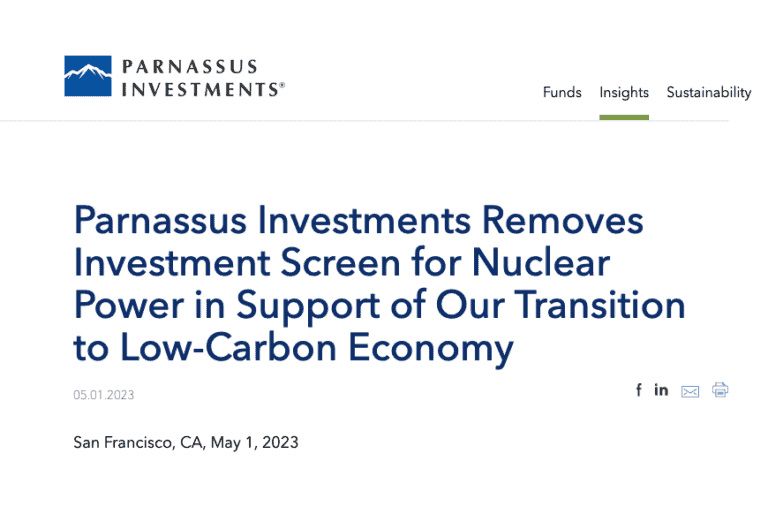Professional climate change mitigation consultant says: “Let’s get real: nuclear is the only option”
By Ben Heard
HOW dare anyone pretend to be surprised by Japan’s reduced emissions target? This was a foregone conclusion with a global element of responsibility and important lessons for Australia.
The frightening loss of the Fukushima Daiichi reactors precipitated the withdrawal from service of Japan’s remaining, largely undamaged nuclear generators for stress testing and additional protective measures. The only feasible result was a dramatic increase in consumption of fossil fuels.
As The Breakthrough Institute reported: “In January 2012 … Japanese utilities increased imports of fuel oil by 165 per cent, crude oil by 174 per cent, LNG by 39 per cent, and coal by 12 per cent.”
This pathway has pushed Japan’s emissions about 100 million tonnes higher per year. Importantly for the 2020 target, the political consequences of the nuclear accident have prolonged this shutdown and also seen about 18 gigawatts of planned and proposed new nuclear build suspended or deferred. With more than 90 per cent of Japan’s emissions coming from the energy sector, expanded nuclear power has undergirded its global commitments from the very beginning.
How did the international community respond to these signs? Did it recognise both the significant challenge and vital importance of the nuclear sector in Japan and the longer term imperative of climate stabilisation?
Did it provide political and diplomatic support for safely restarting the nuclear fleet and resuming planned investments to help Japan meet its target?
Like heck it did. What Japan received was a massive collective dose of radiation freakout. Germany began shuttering nuclear plants, and opening coal with a newly commissioned 725 megawatt coal plant and a further 8000MW to come online in the next two years. France’s socialist candidate promised to cut nuclear generation from about 80 per cent of supply to 50 per cent.
The US responded to a low-risk failure by regulating 2.2GW of Californian nuclear generation out of existence, driving electricity emissions up by 35 per cent. Environmental organisations peddled tales of “the end of Japan”. The Australian Greens remain largely unable to form a sentence that includes “nuclear” without including “cancer”.
Even when four of the world’s leading climate scientists, including Australia’s Tom Wigley, issued a public plea for environmentalists to support deployment of advanced nuclear power, they remained unmoved. No matter which nation, when nuclear generation contracts, fossil generation is the winner, and our greenhouse emissions rise. Where nuclear power expands, fossil combustion is displaced. It is a simple game. Until we build huge quantities of clean energy to replace huge quantities of dirty energy our emissions will grow.
No amount of buck-passing in the form of emissions trading can change that. Facing a profound economic and energy security impact, Japan had no honest choice but to change target. It has taken the slow road to nuclear restart and expansion with our global blessing, facing instead a new fossil fuel bill running at $4 to $5 billion a month. Its stumble on climate change lines the pockets of its energy-exporting trading partners. Curiously, this raises no complaints and elicits no suggestions of sharing the responsibility for the emissions.
Which brings us to Australia. In 1960, we derived 19 per cent of our electricity from renewable sources, compared to 7 per cent today. Growth in renewables has been outstripped by growth in fossil fuels. Prohibition of nuclear power in 1999 left us without a heavy-lifting competitor to coal and gas.
We legislated renewable energy targets, not clean generation targets. In response, wind and solar now provide 3 per cent of electricity in the National Electricity Market. We applied a market-based carbon pricing mechanism while excluding a low-carbon technology from our market. We sell both coal and uranium and refuse to use the latter, while our electricity remains among the dirtiest in the world.
Is it any wonder many Australians suspect our policies are not fair-dinkum attempts to tackle climate change?
Decarbonising Australian electricity by 2050 demands the addition of a whopping 10 terawatt-hours of new clean generation, every single year, from 2015. Attempting that with everything except nuclear will be like attempting the Tour de France with everything except a bicycle.
If Labor prefers a market solution and the Coalition favours direct action, I have a suggestion for both: bipartisan action to dismantle the barriers preventing nuclear power from entering our market. Permit us the solution with the grunt to take on coal and gas. Put processes in place to enable the greatest, most effectively and efficiently regulated nuclear power sector in the world.
Position us to lead with incredible new technology, providing stable, consistently priced, dispatchable zero-carbon generation to do the job properly in partnership with a strong renewables sector. Clean our air of the particulates and toxins from coal burning. Preserve our land from the spread of fossil fuel mining. Build high-technology knowledge and jobs. Give us a credible clean energy vision that will meet the challenges of this century.
Ben Heard is director of ThinkClimate Consulting.
Editor’s note: This op-ed was originally published by The Australian as Let’s get real: nuclear is the only option. It is reprinted here with the permission of the author.
Correction: (November 25, 2013) The initial version of this article put Japan’s fossil fuel bill at $10.8 billion per month, due to a misinterpretation of the statistics provided by Japan Trade Deficit Widens as Fossil Fuel Imports Surge: Economy.

